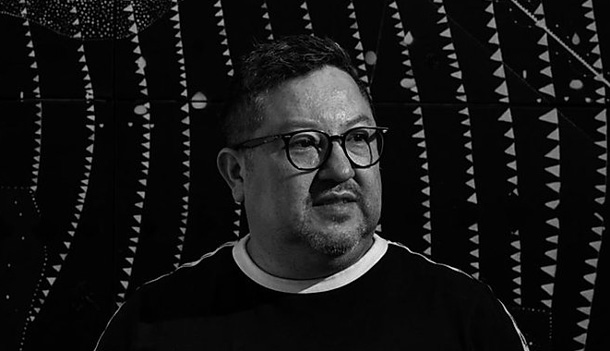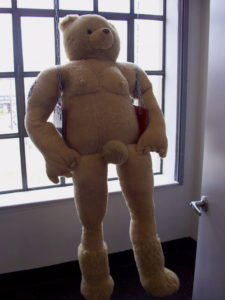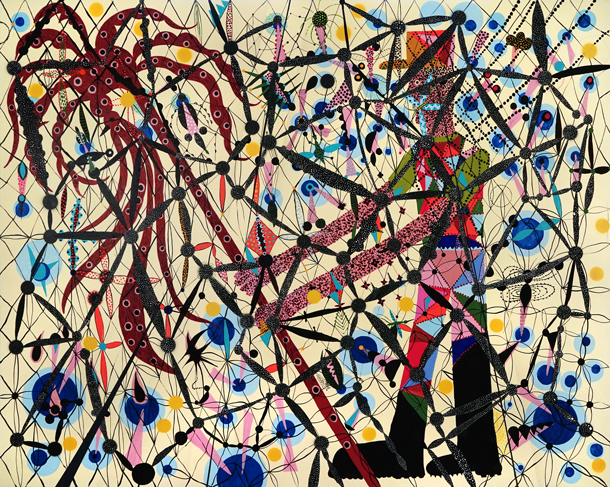
Transcending Borders
Gerardo Rosales’ art showcases the struggles that refugees face while fleeing their countries.

In 2010, during my first year in Houston, I was alerted that there was a bear showing his ass night and day in an upstairs window at Lawndale Art Center. Moving subtly on a swing in the window, Snack Project Teddy was a memorable, human-sized teddy bear exhibit at Houston’s beloved alternative art space on Main Street.
Not all Lawndale visitors would notice Teddy’s perpetual mooning high above the parking lot, or use the somewhat hidden stairs to get to the third-floor studios. But my friends (knowing I was somewhat bear-identified myself) urged me to seek out and cruise Teddy up close.

It turned out that he was—for a teddy bear—pretty butch, with an Army insignia on his muscular arm and quite a large phallic mound, bulgy enough that even a small child would know that this was no asexual companion bear.
Gerardo Rosales, Snack Project Teddy’s creator, hit so many critical points around gay visual culture. After all, 2010 was the year when horny bearded guys on Scruff depicted themselves naked with their junk blocked only by a teddy bear—that funny mix of sexy and goofy that only bear culture welcomed.
I needed to meet the artist.
Turns out, Rosales was an artist from Venezuela who had been living in Houston since 2001, following an active exhibiting career in South America, Europe, and the U.K., where he attended the prestigious Chelsea College of Art with notable artists David Hockney, Chris Offili, and Anish Kapoor.
Back in the day, the link between Caracas (Venezuela’s massive capital city) and Houston was evidenced by the waves of wealthy Venezuelans who descended on The Galleria to shop. However, that ended 15 years ago with Venezuela’s economic collapse.

Fortunately, we have still ended up with a strong cadre of Venezuelan art makers such as Violette Bule and Jan Rattia, who both lived here at various times. As for Venezuelan exhibits, MFAH had a long involvement with the great geometric abstract painter Carlos Cruz-Diez. And Sicardi gallery regularly shows the still-Caracas-based multi-media artist Magdalena Fernandez, whose projected environment in Houston’s recently reopened cisterns thrilled the city in 2016.
And one of Houston’s great underground arts spaces, The Transart Foundation near the Menil museum, was founded by Venezuelan Surpik Angelini. That multidisciplinary space supports experimental work at the intersection of art and anthropology.
It was at the Trans Art Foundation in the spring of 2019 where Rosales made his most authoritative statement on the nature of class, labor, and beauty. His work in London tended to be explicitly about the violence against gay men that he witnessed growing up, including a show in which he depicted gay men as
“piñatas” who were often beaten by police in the cruising parks of Caracas.
But walking into Transart last year, I saw the work uniforms, mops, and functional shoes worn by cleaning women, all decorated with the artist’s signature motifs: spiders, webs, and flowers.
Early Birds, the title of Rosales’ series, referred to the unseen nature of cleaning women’s labor. One dress, titled 4:30am, represented the pre-dawn hour when the women often started to work. The Mexican movie Roma, which told the story of its filmmaker’s childhood memories of the young woman who worked in his home as a maid, was on everyone’s minds when the exhibition opened. Rosales’ exhibit celebrated these laborers’ strength while being unthanked and poorly compensated, and all who saw the show grasped the artist’s message about economic disparities—not only in Venezuela, but also in Houston.
A piece subtitled Gio Ponti was just an excuse refers to the man whose aesthetics defined the global love of Italian design in the 1960s and ’70s via Rosales’ masterpiece in Caracas at the Villa Planchart. When the Planchart commissioned this hilltop gem, the oil-rich country was booming. Today, the perfectly preserved house looks down on the most dangerous major city on the planet, and is a symbol for the death of a generation’s dreams and the plight of so many Venezuelans who can never go back home.

Living between two worlds, Rosales sympathizes with those in foreign countries seeking a better life. He also looks with sorrow and shame on the refugee holding camps on the Texas-Mexico border that should remind Americans that our nation’s promise to welcome the huddled masses is now empty rhetoric.
Rosales’ upcoming show at Lawndale Art Center is inspired by the folk arts he saw as a child in the smaller Venezuelan city of San Cristóbal. High in the mountains near the Colombian border, he absorbed rock aesthetics while watching Cure videos on MTV. In beautifully rendered paintings and an animation, he depicts refugee camps where tent cities make geometric patterns as exhausted refugees are kept marching. In the paintings, the awful realities of border crossing and refugee exploitation by human traffickers are woven into thick visuals. Viewers can be forgiven for thinking this is a celebratory art piece, as Rosales can’t seem to help himself from making beautiful art. His aesthetic decisions make for some complicated contradictions, but the exhibit is ultimately an unforgettable experience with tragedy and joy interwoven.
Keep up with Gerardo Rosales at gerardorosales.net
This article appears in the April 2020 edition of OutSmart magazine.










